UNFORTUNATE AND FORTUNATE DISCOVERIES
 The Derain-Balthus-Giacommeti at the Modern Art Museum was on my list. Off I went on one of those steaming hot days hoping for air conditioning in the museum. The description of the exhibition was "an artistic friendship”. I like all three of those artists -and this was the first time they had been “hung together”. All three shared a desire for modernity and all three were passionate about the old masters and the art of distance civilisations. I was expecting more people but there were few in the first gallery. I soon began to see why this exhibition was not attracting the crowds. I found it very dull - in every sense - dull pictures hung together - dull colours as mainly in the dark browns…and just dull. Despite the size of it, I did not hang around and came out with a dissatisfied taste in my mouth. Individually, some of the paintings were interesting - especially Balthus - but oh dear, not more than a cursory glance did l give to that collection.
So what now?
The Derain-Balthus-Giacommeti at the Modern Art Museum was on my list. Off I went on one of those steaming hot days hoping for air conditioning in the museum. The description of the exhibition was "an artistic friendship”. I like all three of those artists -and this was the first time they had been “hung together”. All three shared a desire for modernity and all three were passionate about the old masters and the art of distance civilisations. I was expecting more people but there were few in the first gallery. I soon began to see why this exhibition was not attracting the crowds. I found it very dull - in every sense - dull pictures hung together - dull colours as mainly in the dark browns…and just dull. Despite the size of it, I did not hang around and came out with a dissatisfied taste in my mouth. Individually, some of the paintings were interesting - especially Balthus - but oh dear, not more than a cursory glance did l give to that collection.
So what now? Then I looked up and saw this…
How could you resist that? It’s a brooch designed by Salvador Dali in 1960. As you can see, the title for the exhibition was MEDUSA, BIJOUX ET TABOUS.

Walking down the stairs your eye is quickly attracted to these neon lights. As it is called 5 Neons, I looked for the other two and never found them

A little way off I could see this large painting by John Armleder (1948) who is a Swiss artist. The title is “Festival of Dolls” (2014). When I read the description at home, I thought it was for something else. This did not seem to fit into his series called Furniture Sculptures. On Internet it was the same description. I’m mystified. But it’s colours and movement are very striking.
The exhibition itself comprises over four hundred pieces of jewellery and seeks the taboos surrounding jewellery building on four themes. Identity, Value, the Body and Ritual. I don’t usually read the description of an exhibition, so unless I have clearly seen the theme I was photographing, there will be no mention of it.
This is a Men’s Chain from the order of Saint-Simon which is politico-religious movement that emerged in France during the 19th century and sought to reconcile Christian values and economic developments. I found the description of this movement quite fascinating. If you want to go further, here is a link.
Henri_de_Saint-Simon

Another point I must add, is that the dates given for each piece of jewellery were over many centuries. A lot of the work, could have been made today.
These necklaces are called “Pearls for Girls” (2012) made by a Manon van Kouswijk.
 They were conceived as a homage to the cabaret singer Suzie Solidor an androgynous icon of Paris night life during th roaring twenties. Early in 1930, she became a popular singer and opened a chic nightclub called La Vie Parisienne. She was openly lesbian.
They were conceived as a homage to the cabaret singer Suzie Solidor an androgynous icon of Paris night life during th roaring twenties. Early in 1930, she became a popular singer and opened a chic nightclub called La Vie Parisienne. She was openly lesbian.The artist is Dutch. The necklaces are very symbolic.
Sylvie Auvray made this necklace in 2015. She is based in Paris and from what I have seen is very into rings. Yet this is a necklace and one would think the ornaments were little figures…(above right);
 |
Verena Sieber-Fuchs is also Swiss born in 1943. However, I would not be too keen on wearing the necklace or is it a collar? It dates from 1984.
Would you believe that this creation is by Calder? Done in 1938.
An anonymous Necklace called the Slave necklace with the Saint Esprit. A little after 1938.
 |
I have always found Louise Bourgeois’s work ambiguous. This necklace she made in the in 1990. It looks more like a slave collar to me.
Right next to it was this virginity belt with an ivory beak created during the XIX century.
A Bedouin veil for the face from Oman. XX century. Well at least you could see through it
.
Man Ray Optic Topic Mask, 1974-78
 |
How do you like this portrait of the Prince Romuald Vmadislav Konstanovitch Giedrïze (1842-1899)

From the XVl century from Spain, a Dragon Pendant. It looks very heavy.
We all know René Lalique. He designed this snake corsage ornament in 1988-99.
Now, from the Cartier Maison. 1968.
Maria Felix, a Mexican actress and a fan of reptiles commissioned this spectacular example from Cartier…
Another snake in our midst. David Bielander. Another Swiss and from what I saw on Internet also creates a lot of jewellery from cardboard.

Is this to be worn or just decoration? A broach done by Hanna Hedman is 2013.
Hanna Hedman (b. 1980, Stockholm) walks a fine line between imagination and reality, art and function. She describes her artistic practice as a dialogue between past, present and parallel worlds.
From what I saw of her work, I would think you added a couple of kilos to your frame if you wore it.
Couldn’t be more kitsch, could it? Ted Noten “Superbitch Bag” (2000).
 |
As early as the middle ages, men or rank wore gold chains. This is the Order of Legion of Honour created by Napoleon in 1802. Martin-Guillaume Biennais is the artist and was Napoleon’s goldsmith. A very well respected one at that.
 |
| Could you guess what this is? |
 |
Before reading the label, I wasn’t totally convinced that these could be earrings. But they are. From the Indian Konar culture and made in the 90’
 |
Nam June Pail was a Korean American artist. (1932-2006) He worked with a variety of media and is considered to be the founder of video art. This pendant “Sense Amplifier, Inhibit Driver” as done around 1967 sums it up.
I don’t think that I would feel too safe with this Lingam 6 Gold (2008) hanging around my neck. The artist Ruudt Peters (1950) is Dutch.
 I know that this is a paper creation, but I am sorry I don’t know who by. I know that this is a paper creation, but I am sorry I don’t know who by. |
It could only be the Liberace collection. The Piano Watch created by an unknown artist in 1965
And his Piano ring created in the 1960 by Mordechai Yerushalmi a “bling bling” jeweller who settled in America in 1976. It’s now a family business and from the look of things, highly profitable.
Michal Jackson’ Victory Tour Crystal Glove made in 1983 by Bill Whitten. Over the years he has designed more costumes for more Grammy winners than he can count. Michael Jackson's beaded, spangled stage clothes are Whitten creations. So are Lionel Richie's, Neil Diamond's and even some of Elton John’s. Bling Bling agai
 |
 |
Although we don’t know made it except that it was the Liberace Candelabra Ring created during the 50’s.
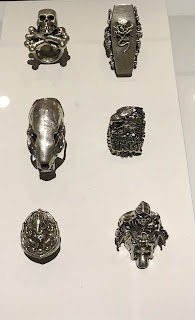 |
These are a series of bikers and hippie’s rings from the second half of the XXth century.
 |
| Ajouter une légende |
Another Swiss designer. Bernard Schonbingher. You know what to do with broken bottles now, don’t you!(2002).
Or how about a dog collar from the second half of the XIXth century.
 |
These three items are from unknown artist. The Money Necklace comes from the ll century?
The earrings are from Mesopotamia - 2500 BC!
And from New Guinea, a breast plate from XiX-XX century. I certainly could not have guessed that the first two items were so old.
The following work is under the banner of Established Values. As a luxury item, jewellery is constantly identified with its materiality, or even materialism. Things do change and a lot of the jewellery we see today the stones may be synthetic…
 |
This is quite a beautiful display unit. Some of the work comes from Cartier and on the right, two pieces are signed by Fulco Verdura and the Main Marchak.
 |
This was made by François Hugo in 1972 and called Max Ernst!
 |
A very ornate Chinese lady’s Head set from the Qing Dynasty. (XlX century.
 |
One of my favourite artists created this brooch in 1940. Alexander Calder.
Janna Syvänoja is Finnish (1963). Shell bracelet designed in 2004.
 |
How about Caroline Broadhead “Rainbow Bangle” (1978). It looks like strands of hair to me.
Caroline Broadhead is a highly versatile artist. Trained as jeweller, she developed her practice beyond this discipline to work on a larger scale, with textiles, light and space and also in collaboration with choreographers for dance performances, winning the Jerwood Prize for Applied Arts: Textiles in 1997.
Not by the artist I mentioned earlier but by an Otto Kûnzli a cardboard bracelet (2015).He is one of the most renowned and respected jewellers working today. The Swiss-trained, Munich-based artist has created truly iconic examples of contemporary jewellery…

It looks huge. A bracelet made by Peter Chang in 1992. There is a lot about a Peter Chang who is a chef…but doubt that this is the right Chinese artist…
In 1960, Van Cleef & Arpels created this Bushy Haired Dog clip…
Of course you have always dreamed on a culinary pipe as a necklace. Gifs Bakker
 |
He is Dutch. Bakker's designs cover jewellery, home accessories and household appliances, furniture, interiors, public spaces and exhibitions.
 |
A rather beautiful pendent made by René Lalique with a rather sad title. “Death of the anemone” (1900-1901)
 |
 | |
A prototype for a CNN necklace designed by Thomas Hirschhorn. Once again a Swiss artist who now lives in Paris. This is made out of cardboard, paper, plastic gold packing paper and scotch.
This is the image of a young mad smoking drugs while filming himself with a webcam. David Douard is the artist. He is French. I first came across his work in 2014 at the Palais de Tokyo. Very curious.
 |
Best known for her work in photography and videos, French artist Marie Angeletti questions the relationship between a work of art and where it is exhibited. This is not unalike a jewellery Christmas decoration. (2016)
 |
 |
Well if you haven’t wanted to wear anything to date, perhaps this “Savage Cord” necklace created by the American Sheila Hicks in 2011
 |
| A fruit necklace (Piero Gilardi) in 1980. |
The 3rd concert was called Bodies and Sculptures. There is definitely a relationship between jewellery and sculpture. In many cases, jewellery can dispense with the body and sometimes some jewellery maintains a co-dependent relationship with the body.
The following work is done by different artists and those masks in the centre are called the days of the week.
A body necklace (Kris Ruhs) in 2003
 |
 |
Purdue Couture (2014) by the Bernadette Corporation, looks most uncomfortable.
Some jewellery is designed to be self-standing or anchored in space and definitely not to be worn.
Without the designers’ names, here is a selection
But this piece, although no designer attributed, is the official ring foe Pope Sixte lV made in the middle of the Xlll century. It bears a considerable stone and is large enough to be worn over liturgical gloves.
There is also what is called “functional jewellery”. Utilitarian jewellery is by no means incidental: these are the portable versions of a wide range of domestic instruments…
and often recycled material. Jewellery is often a fetish object, useful to ward off the evil eye…
 |
 |
 |
 |
 |
 | |
 |
Some of course is utilitarian ….
A watch
A pendant filled with lavender
A relaxation cask-necklace in plastic and shells
Even cure-dents or for ears on a decor of linked hands..(end of the 16th century).
 |
Once upon a time this was an umbrella and now called a Furyu-gasa for the interior . (Amy Yao). She appropriates umbrellas. Some are stripped off their frames and edged with perl necklace
 |
| Egyptian seal ring (1069-945 BC) |
A pair of spurs
 |
 | ||||||||||||||
Or a cheats card ring - (XVlll century) but am not sure how it works..
You may have to work this out for yourselves…
There were Archer’s rings too in the XVl century…
A strange mixture don't you think?
 |
 |
| Multicoloured Bangles (2005) |
This beautiful clock, although too ornate for me was created in
1760-61 by a gold smith and a watch maker…
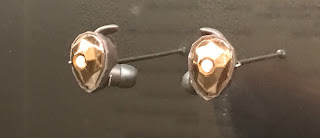 |
| Or Bluetooth headphones…(2017) |
A specific Thermo-sensitve head gear (2014)
This hurts. Auli Laitinen’s brooch - “I am Human” (2001)
 |
 |
A 3D Wave bracelet which looks much easier to wear (2009)
 |
| and this Bitten Crystal Pendant (2005) by Danny McDonald who employs ready-made and recycled objects to produce hybrid sculptures… |
A strange sculpture installation to end with. Spider Woman (Fish Nets), 2015. Liz Craft is a Californian artist. The figure seemed at first glance to be chained, caught in the web of social pressures. Is she gazing? Staring? Or being stared at -
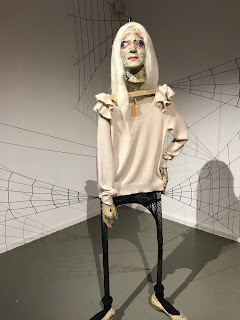 |
 |

Just to finalize the story and finish with a designer I worked for. Paco Rabanne. Coming from the autumn/winter collection in 1968-69, his “Short Dress” and like so many of his creations, who could wear it?

But then I prefer it to this which was standing behind Paco’s couture…or should I say “Haute-Couture”.
And if you really don't know what to do with all those cables - there is the solution of the home necklace...
 | |







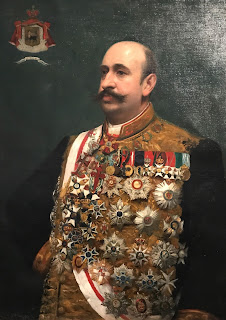





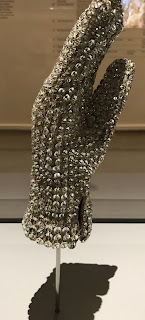
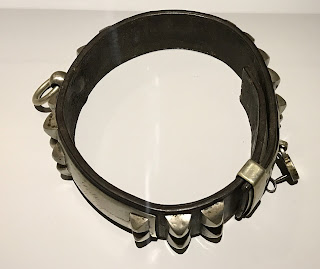






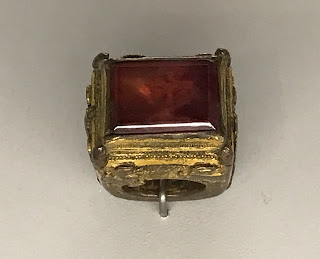












Commentaires